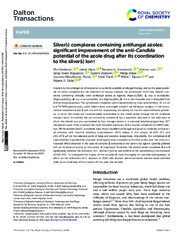Приказ основних података о документу
Silver(I) complexes containing antifungal azoles: significant improvement of the anti-Candida potential of the azole drug after its coordination to the silver(I) ion
| dc.creator | Stanković, Mia | |
| dc.creator | Kljun, Jakob | |
| dc.creator | Stevanović, Nevena Lj. | |
| dc.creator | Lazić, Jelena | |
| dc.creator | Škaro Bogojević, Sanja | |
| dc.creator | Vojnović, Sandra | |
| dc.creator | Zlatar, Matija | |
| dc.creator | Nikodinović-Runić, Jasmina | |
| dc.creator | Turel, Iztok | |
| dc.creator | Đuran, Miloš | |
| dc.creator | Glišić, Biljana | |
| dc.date.accessioned | 2024-01-09T15:13:00Z | |
| dc.date.accessioned | 2024-01-15T16:22:11Z | |
| dc.date.available | 2024-01-09T15:13:00Z | |
| dc.date.available | 2024-01-15T16:22:11Z | |
| dc.date.issued | 2024 | |
| dc.identifier.issn | 1477-9226 | |
| dc.identifier.issn | 1477-9234 | |
| dc.identifier.uri | https://imagine.imgge.bg.ac.rs/handle/123456789/2303 | |
| dc.description.abstract | Inspired by the emergence of resistance to currently available antifungal therapy and by the great potential of metal complexes for the treatment of various diseases, we synthesized three new silver(I) complexes containing clinically used antifungal azoles as ligands, [Ag(ecz)2]SbF6 (1, ecz is econazole), {[Ag(vcz)2]SbF6}n (2, vcz is voriconazole), and [Ag(ctz)2]SbF6 (3, ctz is clotrimazole), and investigated their antimicrobial properties. The synthesized complexes were characterized by mass spectrometry, IR, UV-vis and 1H NMR spectroscopy, cyclic voltammetry, and single-crystal X-ray diffraction analysis. In the mononuclear complexes 1 and 3 with ecz and ctz, respectively, the silver(I) ion has the expected linear geometry, in which the azoles are monodentately coordinated to this metal center through the N3 imidazole nitrogen atom. In contrast, the vcz-containing complex 2 has a polymeric structure in the solid state in which the silver(I) ions are coordinated by four nitrogen atoms in a distorted tetrahedral geometry. DFT calculations were done to predict the most favorable structures of the studied complexes in DMSO solution. All the studied silver(I) complexes have shown excellent antifungal and good to moderate antibacterial activities with minimal inhibitory concentration (MIC) values in the ranges of 0.01–27.1 and 2.61–47.9 μM on the selected panel of fungi and bacteria, respectively. Importantly, the complexes 1–3 have exhibited a significantly improved antifungal activity compared to the free azoles, with the most pronounced effect observed in the case of complex 2 compared to the parent vcz against Candida glabrata with an increase of activity by five orders of magnitude. Moreover, the silver(I)-azole complexes 2 and 3 significantly inhibited the formation of C. albicans hyphae and biofilms at the subinhibitory concentration of 50% MIC. To investigate the impact of the complex 3 more thoroughly on Candida pathogenesis, its effect on the adherence of C. albicans to A549 cells (human adenocarcinoma alveolar basal epithelial cells), as an initial step of the invasion of host cells, was studied. | |
| dc.publisher | Royal Society of Chemistry (RSC) | en |
| dc.relation | Serbian Academy of Sciences and Arts (F128) | en |
| dc.relation | European Cooperation in Science and Technology (CA21145 - COST Action EURESTOP) | en |
| dc.relation | info:eu-repo/grantAgreement/ScienceFundRS/Ideje/7750288/RS// | en |
| dc.relation | info:eu-repo/grantAgreement/MESTD/inst-2020/200042/RS// | en |
| dc.relation | info:eu-repo/grantAgreement/MESTD/inst-2020/200122/RS// | en |
| dc.relation | info:eu-repo/grantAgreement/MESTD/inst-2020/200026/RS// | en |
| dc.relation | Ministarstvo Prosvete, Nauke i Tehnološkog Razvoja - Bilateral project No. 19 between University of Kragujevac, Faculty of Science, Serbia and University of Ljubljana, Faculty of Chemistry and Chemical Technology, Ljubljana, Slovenia | en |
| dc.relation | Javna Agencija za Raziskovalno Dejavnost RS (I0-0022) | en |
| dc.relation | Javna Agencija za Raziskovalno Dejavnost RS ( P1-0175) | en |
| dc.rights | openAccess | |
| dc.rights.uri | https://creativecommons.org/licenses/by-nc/4.0/ | |
| dc.source | Dalton Transactions | en |
| dc.subject | silver(I) complexes | |
| dc.subject | azoles | |
| dc.subject | econazole | |
| dc.subject | voriconazole | |
| dc.subject | clotrimazole | |
| dc.subject | synthesis | |
| dc.subject | characterization | |
| dc.subject | antimicrobial properties | |
| dc.subject | single-crystal X-ray diffraction | |
| dc.subject | coordination | |
| dc.subject | DFT calculations | |
| dc.title | Silver(I) complexes containing antifungal azoles: significant improvement of the anti-Candida potential of the azole drug after its coordination to the silver(I) ion | en |
| dc.type | article | en |
| dc.rights.license | BY-NC | |
| dc.citation.rank | M21~ | |
| dc.identifier.doi | 10.1039/D3DT03010E | |
| dc.identifier.fulltext | https://imagine.imgge.bg.ac.rs/bitstream/id/587798/d3dt03010e.pdf | |
| dc.type.version | publishedVersion |

